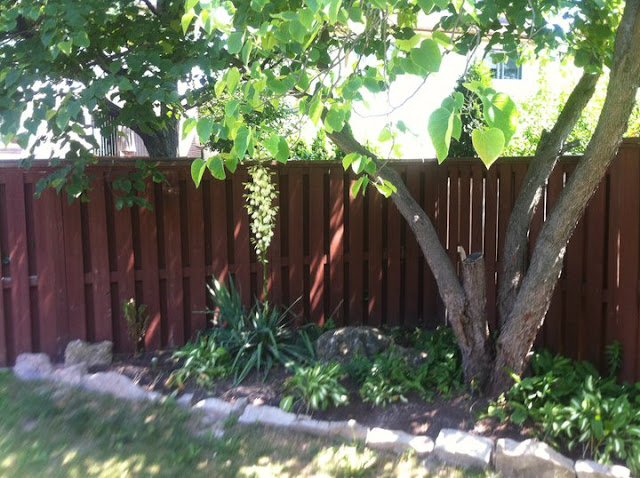My ambition is limited by my yard. As I said in the last post, my yard is not
that big and my herb garden has to share the space with the vegetable garden. My side of the garden also has some shady
spots which don’t necessarily work with the needs of my plants. While I could just accept it and have fewer
herbs in the garden (really?) that’s just not in my nature. There are still other options! I could widen my beds, make new beds, have
window baskets, have a few in containers, and add hanging baskets wherever
possible.
There are some key variables
to solving this space problem:
Basic Survival Needs:
- Annual/Biennial/Perennial
- Light Requirements
- Soil Requirements
- Spread & Spacing
Design &
Aesthetic Choices:
- Height
- Spread
Grouping:
- Annual/Biennial/Perennial
- Uses
Some of these variables are
repeated because they play a role in more than one aspect of my design. (Please note: These were variables that I
felt were important but it may not cover everything, I’m learning by trial and
error here so feel free to comment if I’m missing something here) The most time
consuming aspect of the planning process for me is getting all of the basic
requirements gathered and organized. So
I did some research and made a chart:
Basic Survival
Needs
USE
|
HEIGHT
|
SUNLIGHT
|
SOIL
|
||
Rosemary
|
P
|
E
|
5 FT
|
2
|
S
|
Chives
|
P
|
E
|
1 FT
|
2
|
A-R, M
|
Parsley
|
A
|
E
|
1 FT
|
1
|
R/M
|
Lemon/Italian Basil
|
A
|
E
|
2 FT
|
1
|
R/M
|
Wild Marjoram
|
P
|
E
|
2 FT
|
2
|
R
|
Sage
|
P
|
E
|
2 FT
|
1
|
S
|
Cilantro
|
A
|
E
|
3 FT
|
2
|
R
|
Dill
|
A
|
E
|
4 FT
|
2
|
A-S/M
|
Lemon Balm
|
P
|
M
|
2 FT
|
2
|
S-WD/A
|
Chamomile
|
A
|
M
|
2 FT
|
2
|
A/R
|
Yarrow
|
P
|
M
|
2 FT
|
1
|
P/S/A
|
Echinacea
|
P
|
M
|
3 FT
|
1
|
D/A
|
Feverfew
|
P
|
M
|
CONTAINER
|
2
|
D
|
Hyssop
|
P
|
M
|
3 FT
|
2
|
D/WD
|
Calendula
|
A
|
M
|
3 FT
|
2
|
R/A
|
Beebalm
|
P
|
M
|
4 FT
|
2
|
A/M
|
St. John’s Wort
|
P
|
M
|
3 FT
|
1
|
R/WD
|
Lavendar
|
P
|
M
|
3 FT
|
1
|
S
|
Comfrey
|
P
|
M
|
2 FT
|
2
|
R
|
Valerian
|
P
|
M
|
4 FT
|
1
|
WD
|
With
all of the basic information gathered I could begin sketching out the basic
outline.
---------------------------------------
An important thing to mention
about myself at this point
is that when I take on a task, I tend to focus on the prettier aspects first. Of course, this means that while planning this
garden I’m starting with the basic elements of design and then I’ll eventually
move on to worrying about those little things like the plants basic needs. My first focus is the height of the
herbs. When working on this, I planned
for their long term potential. Since I’m
a visual person – I made some sketches:
Design &
Aesthetic Choices:
.
 |
| The Culinary Herbs |
 |
| The Medicinal Herbs |
The
sketches themselves are rough, and as you can see don’t exactly remain scale, but it gets the
general idea across. It definitely helps me to see it on paper so I
can have some idea of how much plant I’ll be dealing with. However I
was worried that I would run out of space on the page, so I kind of botched the
spread of the plants.
With an idea of the sizes, I moved on to outlining the garden. It was more about creating and blocking space
than placing plants at this point. This
sketch is a rough outline of the back garden with additional beds, like a first
draft of where the plants should go. I'm sorry that it came out so dark.
 |
| Bird's Eye Draft |
Grouping
Before I can commit to anything I have to sketch it out…a lot. With that in mind, I have to consider the garden
in the long term. If I put something in
the wrong space, it would bother me every time I went into the garden. During my research it became apparent that you
should consider how you will group your plants.
One focus is the plants life time: Is it perennial, biennial, or annual? You don’t want to disturb the perennials every
year planting annuals, or so I’ve read.
Another
thing I considered at this point was the use of the herb. It’s always a good call to keep your culinary
herbs closer to the house so you can access them even in bad weather. Some of the herbs also attract bees, and I
don’t really want them buzzing all over me if I’m just relaxing on the
patio. With all things considered, this
is my first draft:
 |
| Current "Final" Draft |
Like I
said, this will probably change – most likely due to practical reasons that I
haven’t considered yet. Are there any
glaringly obvious issues at this point?
Feel free to let me know!


.jpg)
.jpg)






